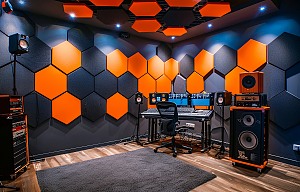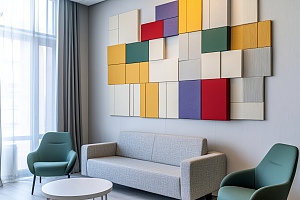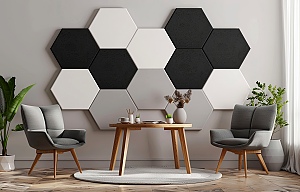When considering the acoustic properties of a room, one of the first things a person usually notices is how loud it is. The quality and shape of the sound, which frequencies are coming through clearly, and other aspects of an audio experience are all less tangible than the sheer volume. Anyone who has spent time in a loud room can attest that the experience would likely have been a lot more pleasant if some of the noise had been dampened. This is precisely what acoustic wall art can do.
However, there is often confusion surrounding sound modification in rooms. Two primary goals are at play: either stopping sound from bleeding out into other spaces or managing the sound within a specific space.
That is why understanding the difference between traditional soundproofing and acoustic wall panels is necessary for getting the results you want.
Understanding Traditional Soundproofing
 Traditional soundproofing is, as the name implies, a way to make a room noise-proof. That means that noises within the room stay in the room and do not escape. It can also mean that outside sounds do not penetrate into the room.
Traditional soundproofing is, as the name implies, a way to make a room noise-proof. That means that noises within the room stay in the room and do not escape. It can also mean that outside sounds do not penetrate into the room.
Soundproofing is primarily used in scenarios where audio quality inside a space is essential. Recording studios, movie theaters, and more all rely on soundproofing to keep loud noises in and reduce sounds from outside. This way, the audio produced inside the room is not mixed with unwanted interference.
However, soundproofing does little to adjust the quality or volume of the sound inside a room. It just keeps it within the confines of that space. Another term for this practice is sound isolation.
How Acoustic Wall Panels Differ
Unlike traditional soundproofing, acoustic wall art fine-tunes the audio experience inside a space. It does not necessarily stop sound from escaping or entering, but it changes how the sound waves move around the room.
For example, when people are having a conversation in a room with flat, glossy walls, they may notice that their conversation echoes. As the sound waves hit the flat wall, they bounce off and re-enter the room. This can create an uncomfortable space, as conversations can quickly become cluttered or drowned out by loud speech.
Acoustic wall panels stop the sound waves from bouncing off the walls, instead absorbing them. This can reduce some of the unwanted noise frequencies within the space, resulting in a clearer and more comfortable sound. It also reduces volume.
How to Maximize the Effect of Wall Panels
 Acoustic wall art is highly versatile, which means that curating the sound experience within a space is as simple as being strategic with the placement of the panels. Here are some important considerations:
Acoustic wall art is highly versatile, which means that curating the sound experience within a space is as simple as being strategic with the placement of the panels. Here are some important considerations:
- More is not necessarily better; instead, placement is the most important aspect. Put panels across from the sources of noise.
- Leave at least three inches (but ideally about a foot) between panels.
- Place the panels at eye level unless there is a specific reason not to do so.
- Don’t forget the ceiling.
Yes, acoustic art can be installed on the ceiling as well to cut down on noise that bounces up above, especially in vaulted ceilings. Because acoustic wall panels are customizable to feature images, patterns, colors, and textures of your choice, you can select something that complements the space.
Can You Do Both?
It is certainly possible to both soundproof a space and control its noise quality with acoustic panels. However, this strategy needs special care. True soundproofing typically requires more substantive changes, such as thicker walls, different types of doors, and better sealing among the seams of the room’s features. Many people enjoy acoustic wall panels because they can help control noise in a space without these more significant investments.
That being said, changing the structure of the building and then adding acoustic art to the final product can produce the most sound-curated space. Less sound will escape or encroach, and the noises within the room will be more pleasant to experience. Whether this is worth the investment depends on the intended use of the space.
Try Acoustic Wall Art Panels for Your Room’s Noise
I f you are struggling to control the audio experience inside your building, acoustic wall art can be a potent yet simple solution. Thanks to the panels’ high customization potential, they are suitable for spaces ranging from modern business offices to comfortable nooks in a residential home. Contact Tree Towns to discuss your current challenges and learn more about the wall panels that could help you curate your noise levels and quality. We can help you get started on a custom order that meets your functional goals and suits your aesthetic preferences.
f you are struggling to control the audio experience inside your building, acoustic wall art can be a potent yet simple solution. Thanks to the panels’ high customization potential, they are suitable for spaces ranging from modern business offices to comfortable nooks in a residential home. Contact Tree Towns to discuss your current challenges and learn more about the wall panels that could help you curate your noise levels and quality. We can help you get started on a custom order that meets your functional goals and suits your aesthetic preferences.
